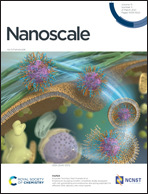Chlorine doping of MoSe2 flakes by ion implantation†
Abstract
The efficient integration of transition metal dichalcogenides (TMDs) into the current electronic device technology requires mastering the techniques of effective tuning of their optoelectronic properties. Specifically, controllable doping is essential. For conventional bulk semiconductors, ion implantation is the most developed method offering stable and tunable doping. In this work, we demonstrate n-type doping in MoSe2 flakes realized by low-energy ion implantation of Cl+ ions followed by millisecond-range flash lamp annealing (FLA). We further show that FLA for 3 ms with a peak temperature of about 1000 °C is enough to recrystallize implanted MoSe2. The Cl distribution in few-layer-thick MoSe2 is measured by secondary ion mass spectrometry. An increase in the electron concentration with increasing Cl fluence is determined from the softening and red shift of the Raman-active A1g phonon mode due to the Fano effect. The electrical measurements confirm the n-type doping of Cl-implanted MoSe2. A comparison of the results of our density functional theory calculations and experimental temperature-dependent micro-Raman spectroscopy data indicates that Cl atoms are incorporated into the atomic network of MoSe2 as substitutional donor impurities.



 Please wait while we load your content...
Please wait while we load your content...